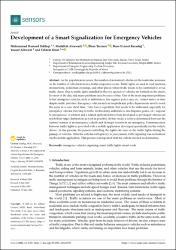Development of a Smart Signalization for Emergency Vehicles

Göster/
Tarih
2023Yazar
Siddiqi, Muhammad HameedAlruwaili, Madallah
Tarımer, İlhan
Karadağ, Buse Cennet
Alhwaiti, Yousef
Üst veri
Tüm öğe kaydını gösterKünye
Siddiqi, Muhammad Hameed, Madallah Alruwaili, İlhan Tarimer, Buse Cennet Karadağ, Yousef Alhwaiti, and Faheem Khan. 2023. "Development of a Smart Signalization for Emergency Vehicles" Sensors 23, no. 10: 4703. https://doi.org/10.3390/s23104703Özet
As the population increases, the number of motorized vehicles on the roads also increases. As the number of vehicles increases, traffic congestion occurs. Traffic lights are used at road junctions, intersections, pedestrian crossings, and other places where traffic needs to be controlled to avoid traffic chaos. Due to traffic lights installed in the city, queues of vehicles are formed on the streets for most of the day, and many problems arise because of this. One of the most important problems is that emergency vehicles, such as ambulances, fire engines, police cars, etc., cannot arrive on time despite traffic priorities. Emergency vehicles such as hospitals and police departments need to reach the scene in a very short time. Time loss is a problem that needs to be addressed, especially for emergency vehicles traveling in traffic. In this study, ambulances, fire brigades, police, etc., respond to emergencies. A solution and a related application have been developed so privileged vehicles can reach their target destination as soon as possible. In this study, a route is determined between the current location of an emergency vehicle and its target location in an emergency. Communication between traffic lights is provided with a mobile application developed specifically for the vehicle driver. In this process, the person controlling the lights can turn on the traffic lights during the passage of vehicles. After the vehicles with priority to pass passed, traffic signaling was normalized via the mobile application. This process was repeated until the vehicle reached its destination.

















